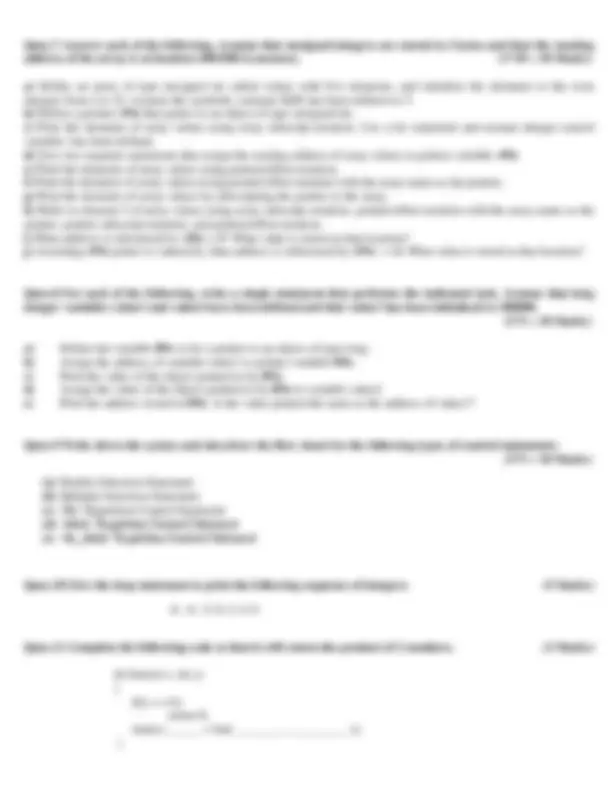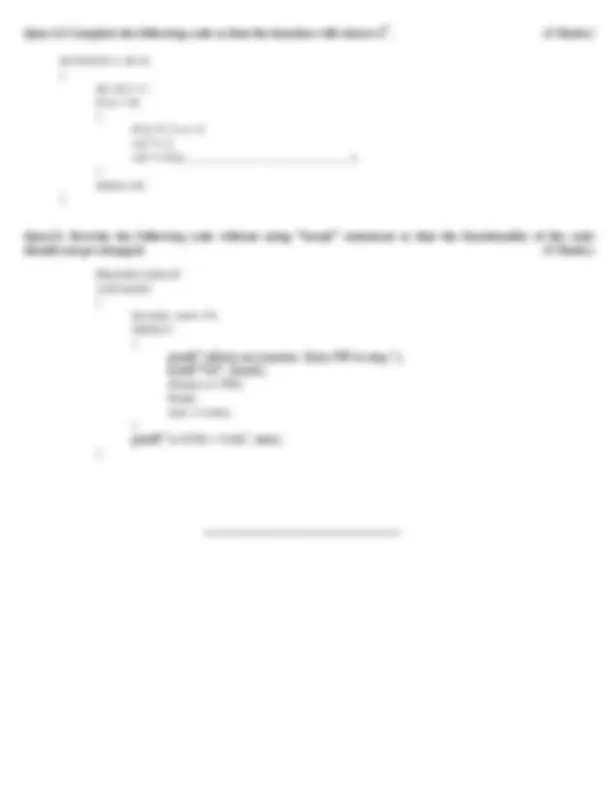




Study with the several resources on Docsity

Earn points by helping other students or get them with a premium plan


Prepare for your exams
Study with the several resources on Docsity

Earn points to download
Earn points by helping other students or get them with a premium plan
Community
Ask the community for help and clear up your study doubts
Discover the best universities in your country according to Docsity users
Free resources
Download our free guides on studying techniques, anxiety management strategies, and thesis advice from Docsity tutors
CSD 101 ENDSEMS 2017, High chance of question getting repeated or getting the similar type of questions, C language.
Typology: Exams
1 / 4

This page cannot be seen from the preview
Don't miss anything!



Programme: B. Tech Discipline: Computer Science and Engineering Exam: End Semester Year: 2016- Course Code: CSD101 Course Title: Introduction to Computing & Programming Date: December 03, 2016 Time: 9.30 AM - 12.30 PM Max. Marks: 100
Ques.1 What, if anything, prints when each of the following C statements is performed? If the statement contains an error, describe the error and indicate how to correct it. Assume the following variable definitions: (2*5 = 10 Marks)
char s1[ 50 ] = "jack", s2[ 50 ] = "jill", s3[ 50 ];
a) printf( "%c%s", toupper( s1[ 0 ] ), &s1[ 1 ] ); b) printf( "%s", strcpy( s3, s2 ) ); c) printf( "%s", strcat( strcat( strcpy( s3, s1 ), " and " ), s2 ) ); d) printf( "%u", strlen( s1 ) + strlen( s2 ) ); e) printf( "%u", strlen( s3 ) );
Ques.2 Fill in the following blanks : (1*10 = 10 Marks)
Ques.3 Convert the following numbers from one base to another. (The intermediate steps must be shown). (1*5 = 5 Marks)
(i) (1100001) 2 = to decimal (ii) (100100.1010) 2 = to octal (iii) (A029) 16 = to decimal (iv) (BABA) 16 = to binary (v) (742) 10 = to binary
Ques.4 What is the difference between constant to pointer and pointer to constant? Explain by giving proper examples for each. Give 3 points of difference including example. (6 Marks)
Ques.5 State whether the following statements are True/False : (1*12 = 12 Marks)
Ques.6 Find the output for the following program segments: (12 Marks)
(i) #include "stdio.h" #include "string.h" void main() { int i=0; for( ; i<=2; ) printf(" %d\n", ++i); }
(ii) void main() { printf("%d", sizeof(5.2)); }
(iii) void main() { int i = 10; static int x = i; if(x == i) printf("Equal"); else if(x > i) printf("Greater than"); else printf("Less than"); } (a) Equal (b) Greater than (c) Less than (d) Compiler Error (e) None of these
(iv) void main() { int num = 5, *ptr = # printf(“%d\n”, *&num); printf(“%d\n”, &&num);
printf(“%d\n”, *&ptr); printf(“%d\n”, &ptr); printf(“%d\n”, &&ptr); }
(v) void main() { int num = 5, ptr = # printf(“%d\n%d”, num, (ptr)--); }
(vi) void main() { int arr[ ] = {1, 2, 3, 4, 5}, i; for(i=0; i<10; i++) *(arr + i) = i; printf(“%d”, arr[3]); }
(vii) #include<stdio.h> void func(int (parr)[3]); void main() { int arr[2][3] = {1, 2, 3, 4, 5, 6}; func(arr); func(arr+1); } void func(int (parr)[3]) { int i; for(i=0; i<2; i++) printf("%d\n", (*parr)[i]); }
n
. (2 Marks)
int foo(int x, int n) { int val = 1; if (n > 0) { if (n % 2 == 1) val *= x; val *= foo( ___________ , ______________ ); } return val; }
Ques13. Rewrite the following code without using “ break ” statement so that the functionality of the code should not get changed: (5 Marks)
#include<stdio.h> void main() { int num, sum = 0; while(1) { printf(“\nEnter any number. Enter 999 to stop:”); scanf(“%d”, &num); if(num == 999) break; sum += num; } printf(“\n SUM = %d\n”, sum); }